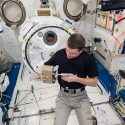There was a young man who lived under a telescope
Ten miles from Madison at the top of a slope,
There lives a young man under a telescope.
Each night as the stars appear in constellations,
He points the instrument toward cosmic destinations.
While the facility may not be as plush as an inn,
It comes with his job at the University of Wisconsin.

Sure, graduate students live in all sorts of places all over town, but probably only one lives underneath a big telescope. As part of his job through the Astronomy Department, Aaron Steffen gets to live an observational astronomer’s dream: to spend each night beneath the giant dome of a working observatory.
Most nights, however, Steffen isn’t there to stargaze. As coordinator of UW–Madison’s Pine Bluff Observatory (PBO), he tidies up the facility, occasionally mows the grass or snow-blows the sidewalks and, more importantly, is on call to help undergraduate data collectors with any telescope problems. In exchange for these services, he lives rent-free in an unusual apartment.
“It’s neat to tell people I live underneath a telescope,” he says.
Many visitors to the PBO, says Steffen, expect to see stars through the telescope. But, although it is an optical telescope, it surveys not stars, but their spectra — the different colors of light they emit. When the telescope is pointed at a star, the bright light reflects off the telescope’s 36-inch round mirror into a device that breaks the light into a spectrum, which is recorded by a special camera similar to the digital cameras now on the market. These spectral data are then sent to the university, where they are stored in compact disks. By studying this information, astronomers can learn about a star’s structure, chemical composition, energy and its nearby environment.
The PBO telescope also includes a special instrument called a spectropolarimeter, which was designed and built by Kenneth Nordsieck, PBO director and astronomy professor. “The spectropolarimeter — the only one in the world that is in continuous use — allows us to study long-term changes in stars,” he says.
Ever since 1958, soon after PBO was built, it has been the university’s primary local observatory for conducting research. The campus’s Washburn Observatory is used mostly for public viewing.
While PBO is now overshadowed by larger, collaborative projects, such as the 3.5-meter WIYN telescope at Kitt Peak in Arizona, many faculty still rely on this smaller telescope for data.
“An important advantage of small telescopes is that one can dedicate them to specialized research,” explains Nordsieck. “Larger telescopes are much more expensive to run, and one has to support many instruments for a large community, with no one astronomer getting much time.”
The PBO telescope can collect data over long periods of time on a single star. In fact, each semester faculty compile “hit lists” of stars. And, each semester, a handful of undergraduates, whose job it is to manage the telescope on clear nights, point the instrument toward the star targets.
Nordsieck says, “Collecting this data takes a lot of observing time, which is where the undergraduate observing team comes in. We get the observing hours needed for the research while giving real-world education experience.”
For these assistants, the experience offers invaluable learning opportunities. Nordsieck says they can gain confidence in operating complex equipment, practice systematic problem-solving skills and establish good habits for data collection.
The students agree, but point out some obvious drawbacks. Since optical telescopes can observe only at night, when light from the sun doesn’t engulf the fainter light from the stars, the students must work when it’s dark. During winter months, that makes for long hours. And, because the telescope is housed in an unheated room with a partially opened roof, the room temperature can dip well below zero.
Fortunately, the students spend most of their time in the observatory’s basement, where they monitor cloud coverage reports on the Internet, check the position of the telescope, flip through some 100 television channels and do homework.
If the students are too tired to drive home when their work is done, bunks beds are available. Though one student observer, Joe Bittner, says, “I’ll usually go home and sleep for a couple hours and then go to class. Last night,” he says as he begins the night shift, “I should have gone to bed a lot earlier.”
As PBO coordinator, Steffen makes himself available at any hour of the night, should the data collectors run into problems “Even though my research doesn’t focus on data collected from PBO, I think it’s wonderful to be able to learn about this type of astronomy,” says Steffen, who studies massive black-holes in distant galaxies by observing their X-ray light.
Nordsieck says that PBO coordinators also receive a valuable education by working at the observatory. “They get a very good understanding of how astronomical instrumentation works — and breaks.”
Add to these benefits the living quarters: a three-bedroom apartment, filled with architectural oddities. One bedroom has rounded walls, the foyer has a trap door through which parts of the instrument are lowered, the living room has a mammoth pillar that supports the telescope and all the windows have thick shades that must be pulled when the telescope is in operation. “Any light from inside can reflect off trees or snow and pollute the light the telescope collects,” Steffen explains.
Though he says the 15-mile commute to campus is long, he does like living at PBO. “On clear nights, you can easily see the streaks of the Milky Way with a naked eye,” he says. His cats, Chester and Hypatia (named after one of the first female astronomers), enjoy the chase of the occasional field mouse that finds its way inside. Plus, Steffen says, rent-free living gives he and his wife, Wendy, the opportunity to save money to start a family. Fortunately for them, the university picks up the electric bill.
Tags: research, space & astronomy



